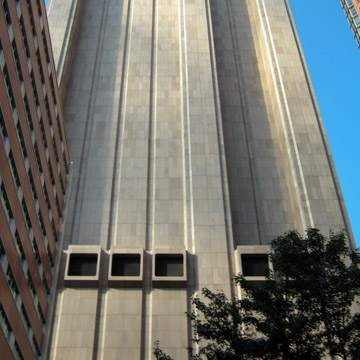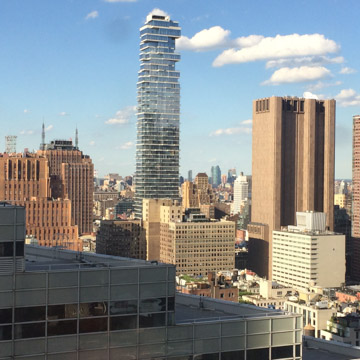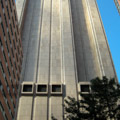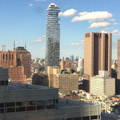The AT&T Long Lines Building is the embodiment of late Bell Telephone System architecture: anonymous, brooding, and forbidding. It rises 29 floors and 450 feet above Thomas Street in lower Manhattan with a sheer, windowless revetment of granite. Aside from the glass doors at its base and openings at the building’s mid-point and peak, there are no windows, only a surface articulated by long, wide-spaced vertical flutes. It suggests the impregnability of a military compound and the precision of an instrument of war. Its defensive posture perfectly captures the mood of an embattled monopoly in its last decade.
When completed, the building accommodated additional volume for reliable, fast, and accessible long-distance service for New York City customers. This required vast floor plates and finely tuned air-conditioning systems that could provide cooled and clean air and process the hot air produced by the switching equipment. It gradually supplanted the aging nearby AT&T Long Lines Building, completed in 1932 on Sixth Avenue by Voorhees, Gmelin and Walker. Today it remains part of the AT&T system, supporting Internet and telephone networks.
Windowless telephone buildings like Warnecke’s Long Lines seem to deny the presence of human occupants, but in fact there was a workforce of engineers and operators in the building. Though small by comparison to the thousands working in the nearby Barclay-Vesey Building, the building population still warranted provision of cafeterias and office spaces. The majority of the structure, however, is given over to equipment rooms. To allow those interior spaces and equipment floors to remain open and flexible for placement of new generations of digital switching technology, Warnecke and Associates, collaborating with Bell engineers, devised a sandwich-like system for the building’s outer walls. Each of the long vertical bays is actually composed of an outward-facing precast concrete panel faced with granite that backs onto a honeycomb of concrete conduits, which is, in turn, backed by a fireproof system of terra-cotta tile. The conduits allowed wire—the foundation of the telephone network—to be threaded through the building facade. The massive hoods at the building’s top rose above the roofline, hiding the structure of the microwave dish that was integrated into the original design.
The gloomy, fenced plaza at the building’s base, provided in compliance with New York’s 1961 zoning law that provided bonus floor space in exchange for publicly accessible areas, contributes to the building’s ability to rise as a sheer, uninterrupted monolith. During the design process the scale and position of the plaza changed several times. Early designs preserved some of the historic structures on Church Street and placed a plaza around them, but ultimately all existing structures on the site were razed. The plaza moved to the building’s rear: mid-block and raised above sidewalk level on a plinth separate from the main building entrance on Thomas Street and away from well-traveled Church Street.
Warnecke had family connections to a Pacific Bell corporate executive, which helped secure this commission as well as others for telephone buildings in California and the new AT&T Long Lines Corporate Headquarters in Bedminster, New Jersey (1977). The Bedminster facility was a companion to the Thomas Street building, and it housed corporate management for AT&T and served as the monitoring station for all long-distance traffic in the U.S. In Warnecke’s files, the Thomas Street building was known as “Project X,” which has helped fuel speculation about its role as a listening center for American intelligence and spy agencies. Artist and film director Laura Poitras’s video installation, Astro Noise, at the Whitney Museum in 2016 featured infrared video of 33 Thomas Street, focusing attention on the role of private telecommunications companies in supporting government surveillance of Internet activity. FBI offices are located a few steps away at Thomas and Broadway in the Jacob K. Javits Federal Building. It is worth noting that the Bell System has long been a partner with American military and government agencies, dating to their involvement in building infrastructure for military communications during both World Wars.
The design of 33 Thomas Street has been subject to controversy and criticism—William Whyte proclaimed it the “world’s tallest blank wall,” which was not intended as a compliment. On the other hand, of all the windowless buildings built by the telephone company, 33 Thomas Street has been one of the most admired, with architectural critic Paul Goldberger suggesting that it was “surely the company’s best.” For his part, Warnecke felt the design added a sense of “monumental grandeur and mystery” to the telephone company’s image. In its exploration of ventilation as a determining factor of form, it partially reflects Reyner Banham’s interest in The Architecture of the Well-Tempered Environment (1969), in which contemporary buildings fully embody the infrastructural systems they employ.
References
Banham, Reyner. The Architecture of the Well-Tempered Environment. London: Architectural Press, 1969.
“Designed for machines but mindful of people.” Architectural Record 146, no. 1 (1969): 123-30.
Gallagher, Ryan and Henrik Molte. “Titanpointe: The NSA’s Spy Hub in New York, Hidden in Plain Sight.” The Intercept, November 26, 2016.
Godel, Addison. "When Windows Were Wires: The Projection of Network Invulnerability and the Architecture of AT&T Long Lines." Grey Room 61 (Fall 2015): 34-65
Goldberger, Paul. “When Building for Future Means a Step Backwards.” New York Times, December 6, 1975.
Whyte, William. City: Rediscovering the Center. (1988). Philadelphia: University of Pennsylvania Press, 2009.




